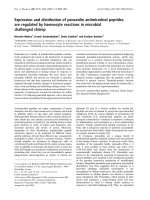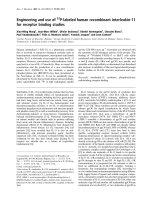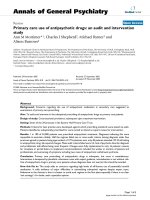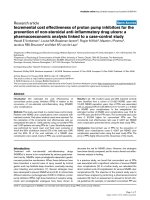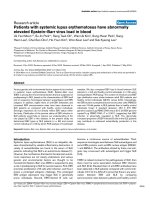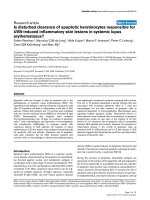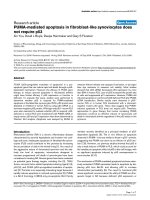Báo cáo y học: " Experience with use of extracorporeal life support for severe refractory status asthmaticus in children" pdf
Bạn đang xem bản rút gọn của tài liệu. Xem và tải ngay bản đầy đủ của tài liệu tại đây (126.96 KB, 8 trang )
Open Access
Available online />Page 1 of 8
(page number not for citation purposes)
Vol 13 No 2
Research
Experience with use of extracorporeal life support for severe
refractory status asthmaticus in children
Kiran B Hebbar
1
, Toni Petrillo-Albarano
1
, Wendy Coto-Puckett
1
, Micheal Heard
3
, Peter T Rycus
2
and James D Fortenberry
1
1
Department of Pediatrics, Emory University School of Medicine, 1405 Clifton Road, Atlanta, GA 30322, USA
2
Extracorporeal Life Support Organization (ELSO), University of Michigan, 503 Thompson Street, Ann Arbor MI 48109-1318, USA
3
Department of Critical Care, Children's Healthcare of Atlanta at Egleston, 1405 Clifton Road, Atlanta, GA 30322, USA
Corresponding author: Kiran B Hebbar,
Received: 25 Sep 2008 Revisions requested: 1 Nov 2008 Revisions received: 8 Jan 2009 Accepted: 2 Mar 2009 Published: 2 Mar 2009
Critical Care 2009, 13:R29 (doi:10.1186/cc7735)
This article is online at: />© 2009 Hebbar et al.; licensee BioMed Central Ltd.
This is an open access article distributed under the terms of the Creative Commons Attribution License ( />),
which permits unrestricted use, distribution, and reproduction in any medium, provided the original work is properly cited.
Abstract
Introduction Severe status asthmaticus (SA) in children may
require intubation and mechanical ventilation with a subsequent
increased risk of death. In the patient with SA and refractory
hypercapnoeic respiratory failure, use of extracorporeal life
support (ECLS) has been anecdotally reported for carbon
dioxide removal and respiratory support. We aimed to review the
experience of a single paediatric centre with the use of ECLS in
children with severe refractory SA, and to compare this with
international experience from the Extracorporeal Life Support
Organization (ELSO) registry.
Methods All paediatric patients (aged from 1 to 17 years) with
primary International Classification of Diseases (ICD)-9
diagnoses of SA receiving ECLS for respiratory failure from both
the Children's Healthcare of Atlanta at Egleston (Children's at
Egleston) database and the ELSO registry were reviewed.
Results Thirteen children received ECLS for refractory SA at
the Children's at Egleston from 1986 to 2007. The median age
of the children was 10 years (range 1 to 16 years). Patients
generally received aggressive use of medical and anaesthetic
therapies for SA before cannulation with a median partial
pressure of arterial carbon dioxide (PaCO
2
) of 130 mmHg
(range 102 to 186 mmHg) and serum pH 6.89 (range 6.75 to
7.03). The median time of ECLS support was 95 hours (range
42 to 395 hours). All 13 children survived without neurological
sequelae. An ELSO registry review found 64 children with SA
receiving ECLS during the same time period (51 excluding the
Children's at Egleston cohort). Median age, pre-ECLS PaCO
2
and pH were not different in non-Children's ELSO patients.
Overall survival was 60 of 64 (94%) children, including all 13
from the Children's at Egleston cohort. Survival was not
significantly associated with age, pre-ECLS PaCO
2
, pH, cardiac
arrest, mode of cannulation or time on ECLS. Significant
neurological complications were noted in 3 of 64 (4%) patients;
patients with neurological complications were not significantly
more likely to die (P = 0.67).
Conclusions Single centre and ELSO registry experience
provide results of a cohort of children with refractory SA
managed with ECLS support. Further study is necessary to
determine if use of ECLS in this setting produces better
outcomes than careful mechanical ventilation and medical
therapy alone.
Introduction
Asthma is a growing health problem in the USA, affecting over
9 million children under the age of 18 years [1]. Asthma prev-
alence is at historically high levels, and it remains the most
common cause of hospitalisation among children [1], with
rates highest among African American children [2,3].
DHI: dynamic hyperinflation; ECLS: extracorporeal life support; ELSO: Extracorporeal Life Support Organization; ICD: International Classification of
Diseases; ICU: intensive care unit; MAC: minimum alveolar concentration; PaCO
2
: partial pressure of arterial carbon dioxide; PaO
2
: partial pressure
of arterial oxygen; PEEP: peak end expiratory pressure; PICU: paediatric intensive care unit; PIP: peak inspiratory pressure; SA: status asthmaticus;
VA: venoarterial; VV: venovenous.
Critical Care Vol 13 No 2 Hebbar et al.
Page 2 of 8
(page number not for citation purposes)
Status asthmaticus (SA) is also a very common indication for
admission to the paediatric intensive care unit (PICU). SA is
defined as failure of conventional therapy with progression
towards respiratory failure due to asthma [4]. SA can progress
quickly to a life-threatening emergency in children. Death rates
attributable to asthma and SA have been reported at 2.6 per
1 million children annually (186 children) with a significantly
higher rate in African American children aged 0 to 17 years of
about 9.2 per 1 million [1]. Patients with previous ICU admis-
sions, recurrent hospitalisation and those requiring mechani-
cal ventilatory support have an increased risk of a fatal
outcome [5-7].
In addition to the routine administration of continuous neb-
ulised beta-adrenergic agonists with intermittent anticholiner-
gics, corticosteroids and oxygen, adjunctive therapies such as
magnesium sulfate, methylxanthines, helium-oxygen mixtures,
noninvasive ventilation and intravenous beta-agonists have
been employed to avoid respiratory failure and intubation [4].
However, a small number of patients fail to respond to these
aggressive treatments and require mechanical ventilation. Up
to 20% of children with SA admitted to PICUs [8,9] require
intubation, with a subsequent increased risk of death [8,9]. An
earlier report found that 10% of patients intubated in a PICU
had preceding respiratory or cardiopulmonary arrest [10].
Extracorporeal life support (ECLS) could provide adjunctive
pulmonary support for intubated asthmatic patients who
remain severely acidotic and hypercarbic in spite of aggressive
conventional therapy and unconventional therapies, including
inhaled anaesthetics [11]. Although potentially helpful, there
has been little experience with ECLS in refractory SA reported.
Anecdotal case reports have described its use in adults [12-
15] and rarely in children [16]. No extensive case review of
ECLS in SA exists in the literature. We have noted increased
need for and use of extracorporeal support for children with
SA failing aggressive medical and anaesthetic therapy in our
PICU, and sought to evaluate our single centre experience
with this approach. For comparison, we queried an interna-
tional ECLS database to evaluate paediatric experience with
the use of ECLS in patients with severe SA.
Materials and methods
We queried the ECLS institutional database at Children's
Healthcare of Atlanta at Egleston (Children's at Egleston) for
paediatric patients with status asthmaticus (International Clas-
sification of Diseases (ICD)-9 code 493.91) receiving extra-
corporeal support at our institution. Children's at Egleston is a
freestanding quaternary referral medical centre with 232 inpa-
tient beds and a 30-bed multidisciplinary (non-cardiac) medi-
cal-surgical intensive care unit (ICU). The need for informed
consent was waived and institutional review board approval
was obtained for collection of deidentified data on demo-
graphic characteristics, hospital course before ECLS, ventila-
tory parameters, arterial blood gas measurements and
therapeutic interventions before cannulation. The course of
ECLS, complications and outcome were also reviewed.
For comparison with our centre series, we reviewed interna-
tional experience with ECLS use in children with SA through
the Extracorporeal Life Support Organization (ELSO) registry.
The ELSO registry is a voluntary database tracking consecu-
tive ECLS patient experience for neonates, children and adults
from over 100 centres since 1985 [17]. Following a formal
request to review the ELSO registry database, approval was
granted from the Protocol Chairman of ELSO Registry Com-
mittee. Access to the database was obtained through our cen-
tre's membership. The ELSO database was queried for
directed review of all patients from age 1 to 17 years with a pri-
mary ICD-9 diagnosis (493.91) of SA in respiratory failure
receiving ECLS.
At Children's at Egleston, bedside point-of-care devices
(iSTAT; Abbott Point of Care Inc., Abbott Park, Illinois, USA)
are routinely used for blood gas measurement. With this
device, the maximal value reported and displayed for partial
pressure of arterial carbon dioxide (PaCO
2
) is 'greater than
130 mmHg'. Therefore, for statistical analysis of these values,
the value 130 mmHg was used if a maximal PaCO
2
value was
reported. However, based on simultaneous pH measure-
ments, it is likely that traditional blood gas analyser measure-
ments of PaCO
2
would have yielded significantly higher
values.
Ventilatory support for SA in intubated patients in the Chil-
dren's at Egleston PICU is typically performed using pressure
controlled ventilation (Siemens Servoi; Maquet, Bridgewater,
NJ, USA). Mechanical ventilation at our centre is directed at
allowing adequate expiratory effort, with relatively short inspir-
atory time and longer expiratory times, with respiratory rates
decreased to allow for improved lung emptying based on aus-
cultation, ventilator graphics and measurement of inspiratory
plateau pressures. Lower (but not zero) positive end-expiratory
pressures are also utilised. Inhaled anaesthesia is provided
using isoflurane or sevoforane at minimum alveolar concentra-
tion (MAC) starting at 0.5% up to maximum 1.0%. Choices for
individual therapies in severe SA were based on physician dis-
cretion.
Statistical analysis of data was performed comparing pre-
ECLS variables, complications and outcomes using standard
statistical software (Sigma-Stat; Systat Software Inc., Rich-
mond, CA, USA). Analysis was performed comparing patients
from Children's at Egleston, all patients identified from the
ELSO registry and ELSO registry patients excluding those
from Children's at Egleston (who are also captured in the
ELSO registry).
Available online />Page 3 of 8
(page number not for citation purposes)
Results
Experience of Children's at Egleston
From 1986 to 2007, 13 patients received ECLS support for
refractory SA and hypercarbic respiratory failure failing treat-
ment with conventional and alternative medical therapy (Table
1). Seven of these patients were cannulated in 2006 and
2007 alone. Median patient age was 10 years (range 1 to 16
years). Patients had a median of 3.5 hospitalisations for
asthma (range 1 to 4) prior to ECLS hospitalisation. Three of
the 13 (23%) children had been previously intubated for
asthma. Of the 13 patients at Children's, 93% chronically
received inhaled beta agonists, 85% were on daily inhaled cor-
ticosteroids and 62% received leukotriene inhibitors at the
time of admission. Ten patients were intubated and transferred
from an outside medical centre, and only three were intubated
at our facility due to respiratory failure.
Therapeutic interventions for treatment of SA for each patient
are shown in Table 2. Prior to initiation of ECLS, all 13 patients
at Children's at Egleston received continuous inhaled beta
agonists and anticholinergics, intravenous beta agonist (terb-
utaline) infusion and intravenous corticosteroids. Additionally,
92% received intravenous ketamine infusion, 77% received
helium-oxygen blended in ventilator gases and 69% received
intravenous magnesium sulfate. Eight of 13 (62%) children
also received inhaled anaesthetic agents inline before cannu-
lation. Three of the 13 (31%) children received continuous
intravenous theophylline infusion, but none after 1997.
Median time from patient intubation to ECLS institution was
14 hours (range 1 to 34 hours). Prior to ECLS cannulation,
median patient arterial pH was 6.93 (range 6.78 to 7.03), and
median PaCO
2
was at least 130 mmHg prior to cannulation.
Maximum ventilator settings prior to ECLS cannulation
included median peak inspiratory pressure (PIP) of 51.5
cmH
2
O (range 40 to 72 cmH
2
O), respiratory rate 12 breaths/
minute (range 10 to 25 breaths/minute), peak end expiratory
pressure (PEEP) 5 cmH
2
O (range 0 to 15 cmH
2
O) and venti-
lator mean airway pressure of 19 cmH
2
O (range 9 to 24
cmH
2
O). Four patients experienced cardiorespiratory arrest
prior to ECLS. Two of these events occurred at outside hospi-
tals and two events, brief in nature, occurred shortly before
ECLS was initiated. No cardiorespiratory arrest episodes
occurred during ECLS.
Twelve of 13 patients were cannulated by the venovenous
(VV) approach. A single patient underwent the venoarterial
(VA) approach due to requiring cardiopulmonary resuscitation
during cannulation. Median time spent on ECLS was 95 hours
(range 42 to 395 hours). One patient developed pulmonary
haemorrhage associated with Stachybotrys chartarum infec-
tion and required ECLS for 395 hours. Median time of ventila-
tion after decannulation until extubation was 52 hours (range
18 to 393 hours), and median time to PICU discharge after
decannulation was 125 hours (Tables 3 and 4).
Complications relating to SA and ventilation were common
prior to cannulation. Pneumothorax occurred in 2 fo 13 (15%)
patients prior to admission to the Children's at Egleston PICU.
Table 1
Demographic and clinical variables for patients receiving extracorporeal life support for status asthmaticus at Children's Healthcare
of Atlanta at Egleston from 1986 to 2007
Patient Year ECLS
performed
Race Total ECLS run
time (hours)
Ventilator hours prior
to ECLS initiation
Serum pH prior to
ECLS
Serum PaCO
2
prior
to ECLS (mmHg)
Ventilator hours after
ECLS until extubation
1 1994 AA 135 20 7.02 102 288
2 1995 C 184 10 6.83 172 89
3 1996 AA 63 17 6.83 186 44
4 1997 AA 174 34 6.98 151 51
5 2002 C 395 24 6.75 190 383
6 2004 AA 100 9.5 6.94 > 130 72
7 2006 AA 106 32 7.03 101 38.5
8 2006 C 95 20 6.93 > 130 142
9 2006 C 66 14 6.99 106 17.5
10 2007 AA 52 12 7.0 127 46
11 2007 AA 48 12 6.85 > 130 30
12 2007 AA 42 4 6.8 > 130 53
13 2007 AA 70 1 6.78 > 130 40
AA = African-American; C = Caucasian; ECLS = extracorporeal life support; PaCO
2
= partial pressure of arterial carbon dioxide.
Critical Care Vol 13 No 2 Hebbar et al.
Page 4 of 8
(page number not for citation purposes)
Of concern, two of 13 (15%) children demonstrated unilateral
pupillary dilation prior to cannulation with concern for
increased intracranial pressure and cerebral oedema. Neither
patient had undergone prior cardiorespiratory arrest or signifi-
cant hypoxia. Computerised tomography did not reveal intrac-
ranial abnormalities in either patient. Only one of these
patients had accompanying neurological changes (seizure).
Abnormalities had resolved at time of decannulation. Four of
thirteen (31%) patients experienced cardiorespiratory arrest
prior to ECLS while in the PICU.
Experience of ELSO registry
Sixty-four patients meeting criteria from the ELSO registry
were identified. Of the 64, 13 of these patients were regis-
tered from Children's at Egleston; thus analysis was per-
formed on both the total 64 SA patients and on the 51 non-
Children's at Egleston ELSO SA patients (Table 3).
A significant increase in reported ECLS cases for SA was
found from 2002 to 2007 (42 of 64; 66%) compared with
1986 to 2002 (23 of 64; 34%; P < 0.0001). Median age of
the 64 ELSO registry patients was 10 years (range 1 to 17
years). Median time from intubation to institution of ECLS was
15 hours (range 1 to 230 hours). Median ventilator settings
prior to ECLS cannulation included PIP of 44 cmH
2
O, PEEP
of 5 cmH
2
O, ventilator rate of 14 breaths/minute and ventilator
mean airway pressure of 15 cmH
2
O.
No differences were seen between ELSO patients and Chil-
dren's at Egleston patients alone in pre-ECLS variables. High
frequency oscillatory ventilation was initiated in 6 of 64 (9%);
none of these children were from our facility.
For ELSO registry patients, median serum pH prior to ECLS
was 6.96 (range 6.78 to 7.28). Median PaCO
2
was 123
mmHg (range 70 to 237 mmHg), and partial pressure of arte-
rial oxygen (PaO
2
) was 126 mmHg (range 59 to 636 mmHg).
Survival in patients with pre-ECLS PaCO
2
less than 100
mmHg was no different than in patients with PaCO
2
greater
than 100 mmHg (10/11 vs. 50/53; not statistically significant).
No correlation was found between decreased serum pH less
than 7.0 at time of cannulation and survival. No patient had sig-
nificant hypoxaemia (PaO
2
greater than 50 mmHg) reported at
the time of cannulation.
Of 64 ELSO patients, 55 (86%) had VV cannula configuration
for ECLS support and 9 (14%) had VA support. One patient
was converted from VV to VA support during the ECLS run.
Reported ELSO use of VV for cannulation increased over the
course of the study period, with 38 of 41 (93%) patients hav-
ing VV ECLS from 2002 to 2007 compared with 17 of 23
(74%) patients from 1986 to 2001 (p = 0.305). Overall ECLS
survival was 60 of 64 (94%) patients, including all 13 from our
institution. Median time of ECLS support was 94 hours. All
nine VA patients (100%) survived compared with 51 of 55 of
VV patients (93%; P = 0.78). No statistically significant differ-
ence in ECLS variables or outcomes was seen between non-
Table 2
Medical and anaesthetic therapies used in 13 patients placed on extracorporeal life support at Children's Healthcare of Atlanta at
Egleston between 1986 and 2007
Patient IV beta agonist Ketamine Magnesium sulfate Helium-oxygen Theophyline infusion Inhalational agent
1YYNYYY
2YYNNYN
3YYNNNY
4YNNYYY
5YYYYNY
6YYYYNY
7YYYYNN
8YYYYNY
9YYYYNY
10 Y Y Y N N N
11 Y Y Y Y N N
12 Y Y Y Y N N
13 Y Y Y N N Y
Total percentage receiving therapy 100% 92% 69% 69% 23% 62%
Available online />Page 5 of 8
(page number not for citation purposes)
Children's at Egleston ELSO patients and Children's at Egle-
ston patients alone.
Cardiovascular, haemorrhagic and mechanical complications
were most commonly reported (Table 4). Cardiovascular prob-
lems included hypertension in six patients and vasopressor
requirements in 15 children. Four of 64 patients experienced
central nervous system complications, including seizures and
intracranial haemorrhage. However, the presence of neurolog-
ical complications was not associated with an increased likeli-
hood of death. Children's at Egleston patients reported
significantly higher rates of haemorrhagic (cannula site bleed-
ing), metabolic (hyperglycaemia) and infectious complications
when compared with ELSO patients (Table 4).
Table 3
Demographic and clinical data for all ELSO registry patients, ELSO registry patients excluding patients from Children's Healthcare
of Atlanta at Egleston, and Children's at Egleston patients alone
All patients (n = 64) median
(range)
ELSO alone (n = 51) median
(range)
Children's at Egleston (n = 13) median
(range)
Age (years) 10
(1 to 17)
10
(1 to 17)
10
(1 to17)
Hours on ECLS (hours) 93
(31 to 395)
91
(31 to 218)
97.5
(42 to 395)
Survival (%) 60/64 (95%) 47/51 (92%) 13/13 (100%)
PEEP (cmH
2
O) 5
(0 to 20)
5
(0 to 20)
5
(0 to 15)
PIP (cmH
2
O) 44
(23 to 130)
42
(23 to 130)
51
(40 to 80)
MAP (cmH
2
O) 15
(3 to 48)
16
(3 to 48)
19
(9 to 24)
Cardiorespiratory arrest prior to ECLS
(%)
9/64 (14%) 5/51 (10%) 4/13 (31%)
pH 6.98
(6.75 to 7.28)
6.98
(6.78 to 7.28)
6.89
(6.75 to 7.03)
PaCO
2
(mmHg) 122
(61 to 284)
121
(61 to 284)
130
(102 to 186)
Percentage VV cannulation use 86% 82% 92%
No significant differences were noted between group variables.
ECLS = extracorporeal life support; ELSO = Extracorporeal Life Support Organization; MAC = minimum alveolar concentration; PaCO
2
= partial
pressure of arterial carbon dioxide; PEEP = peak end expiratory pressure; PIP = peak inspiratory pressure; VV = venovenous.
Table 4
Complications reported for all ELSO registry patients, patients from Children's Healthcare of Atlanta at Egleston alone (CHOA) and
ELSO registry patients excluding Children's at Egleston patients (non-CHOA)
Organ system
dysfunction
All ELSO patients
(n = 64)
CHOA alone (n = 13) ELSO alone (n = 51) Number of ELSO non-
survivors with
complication*
CHOA vs. non-CHOA
p value
CNS 4 (6%) 2 (14%) 2 (4%) 1 0.153
Cardiovascular 21 (33%) 5 (38%) 16 (31%) 3 0.421
Haemorrhagic 15 (23%) 7 (54%) 8 (16%) 1 0.001**
Mechanical 15 (23%) 4 (31%) 11 (22%) 1 0.276
Pulmonary 9 (14%) 3 (23%) 6 (12%) 2 0.123
Metabolic 20 (31%) 9 (69%) 11 (22%) 1 0.0001**
Renal 12 (18%) 3 (21%) 9 (18%) 2 0.354
Infectious 10 (16%) 7 (54%) 3 (6%) 1 0.0001**
All values expressed in number (percentage). * All patients at Children's at Egleston survived. ** Statistically significant.
CHOA = Children's Healthcare of Atlanta at Egleston; CNS = central nervous system; ELSO = Extracorporeal Life Support Organization.
Critical Care Vol 13 No 2 Hebbar et al.
Page 6 of 8
(page number not for citation purposes)
Discussion
This report provides, to date, the largest single centre experi-
ence and the largest international case series of ECLS use in
severe SA. Although it provided accumulated experience with
ECLS use in severe SA, certain limitations require discussion.
This review is inherently limited in its conclusions because of
the retrospective nature of the data available both from our
institution and from the ELSO registry. Of particular concern,
no specific criteria were used to initiate ECLS. Therefore, it is
difficult to conclude from this data specific indications for use
of ECLS in SA. Evaluation of intensity of asthma therapy prior
to ECLS is impossible to interpret in ELSO registry patients
because of the voluntary nature of reporting and the lack of
available detailed data on ventilator settings and medical ther-
apy. However, more specific information on medical therapies
and ventilator settings in SA patients from our single centre
could be helpful in evaluating the timing of initiation of ECLS
in this subset.
ELSO experience demonstrates a significant increase in
reported use of ECLS for SA and respiratory failure since
1995. This rise could be the result of an increasing number of
centres performing ECLS, or increased comfort with use of
ECLS in this setting based on experience. However, other fac-
tors could be responsible, including higher asthma preva-
lence, increasing regional incidence or severity of asthma, or
overall increasing severity of illness.
National trends in asthma could be impacting ECLS use.
Ambulatory visits for children with asthma have continued to
increase nationally since 2000 [1]. However, inpatient admis-
sion rates are unchanged, suggesting that a higher threshold
for hospitalisation for asthma exists, and that hospitalised
asthma patients are more severely ill at time of admission [3].
Of note, use of ECLS at our institution represents a significant
number (20%) of the reported ELSO cases. This finding could
be the result of regional asthma severity, lack of aggressive
medical or ventilatory therapies or an institutional tendency to
turn to ECLS early in severe SA.
Regional severity of asthma could also have resulted in
increased use of ECLS in our institution. Asthma incidence
and severity have grown in Georgia. Eleven percent of children
in Georgia aged 0 to 17 years have asthma [18], making it a
state with one of the highest asthma prevalence rates in the
country. Children living in high areas of air pollution have
higher baseline asthma severity [19]. Atlanta, the home for a
majority of patients in our single centre series, was recently
ranked poorly among major USA cities for year-round particle
pollution and ozone pollution [20] and for overall livability for
atopic individuals [21]. Atlanta is also noted to have a crude
paediatric and adult asthma death rate worse than the national
average [21]. Racial composition of asthma patients in our
centre could also have been a factor in the rise in use of ECLS.
Disparities in adverse outcomes such as emergency depart-
ment visits, hospitalisations and death are substantially higher
for African-American children [1]. Nine of 13 (69%) patients in
the Children's at Egleston cohort were African-American.
Mortality from asthma is potentially avoidable [3] but increases
with the need for mechanical ventilation [8,22]. The majority of
our patients (10 or 13 or 77%) were intubated at outlying facil-
ities and received varied therapy before transfer to our institu-
tion. This experience agrees with recent studies
demonstrating a significantly increased incidence of intubation
at community facilities when compared with children's hospi-
tals [23,24]. The decision to intubate an asthmatic should not
be made without exhausting all therapeutic options including
non-invasive positive pressure ventilation [25]. Review of the
experience at our centre suggests that medical therapies
(Table 2) were assertively used. Ventilator therapies appeared
consistent with accepted approaches reported elsewhere [4],
and a median time of 14 hours before ECLS use suggests sig-
nificant interventions were attempted before turning to ECLS.
Dynamic hyperinflation (DHI) chiefly contributes to increasing
mortality in an intubated asthmatic patient [6]. Recommended
ventilator strategies in SA and DHI are focused on allowing
maximal emptying times through low ventilator rates and allow-
ing spontaneous respiration if possible. It is possible that
some ELSO registry patients did not receive optimal ventilator
strategies prior to cannulating for ECLS. However, the data
shows low median ventilator rates and PEEP values prior to
ECLS suggesting that, in general, these approaches were
taken. Similarly, multiple adjunctive medical therapies have
been used and suggested for severe SA, including theophyl-
line, magnesium sulfate, helium-oxygen (heliox) and inhaled
anaesthesia [4]. Although the ELSO registry does not provide
detailed data on therapy, our institutional data is able to dem-
onstrate aggressive and broad-based medical therapies
attempted before resorting to ECLS cannulation.
ECLS in an asthmatic patient allows for lung rest, providing
time for bronchiolar relaxation, aggressive pulmonary toilet and
even controlled bronchoscopy if needed for plastic bronchitis
[26,27]. ECLS cannulation may be performed either with VA
or VV cannulation techniques. VV ECLS offers advantages of
preserved pulmonary blood flow, preservation of the carotid
artery, improved oxygenation of the myocardium, physiological
left ventricular cardiac output providing pulsatile blood flow
and preservation of normal cerebral blood flow velocities [28].
VA cannulation has the added risks of carotid ligation, cardiac
stun and increased cardiac afterload, which can be minimised
with VV ECLS. Use of VV support has generally increased rel-
ative to VA over the past decade for respiratory failure ECLS
[28]. VV support is likely to be the best choice for an asthmatic
patient given the relatively low blood flows required to remove
plasma carbon dioxide and lack of need for cardiac support.
Available online />Page 7 of 8
(page number not for citation purposes)
Other devices can provide extracorporeal carbon dioxide
removal in a pumpless fashion [29].
Mortality in SA secondary to air leak syndromes and cerebral
oedema may be unavoidable with most conventional medical
and ventilatory therapies.
Although permissive hypercapnoea has become an important
strategy in ventilating asthmatic patients [4,30,31], no consen-
sus exists regarding acceptable levels of hypercapnoea. Sev-
eral case reports describe diffuse cerebral oedema,
subarachnoid haemorrhage, quadriparesis, hyperreflexia and
extensor plantar reflexes associated with severe hypercarbia in
SA [32-36]. In one report, an 11-year-old patient with asthma
developed subarachnoid haemorrhage thought to be second-
ary to hypercarbia with a maximum PaCO
2
of 135 mmHg [32].
CNS complications associated with hypercarbia are likely to
be due to dilation of cerebral vasculature and marked
increases in cerebral blood flow [37]. Blood flow changes
coupled with decreased venous return secondary to increased
intrathoracic pressure and prolonged acidosis may produce
cerebral oedema, stroke and even death in patients with
asthma [32,34,35]. Elevated tau protein, associated with neu-
ronal cell death, has been reported in the cerebrospinal fluid of
an asthmatic patient with hypercarbia [38].
Central nervous system complications occurred in four ELSO
registry patients. Of note, these were not associated with prior
cardiorespiratory arrest or survival. However, it is impossible to
ascertain the timing of either injury or arrest relative to ECLS
initiation from the registry, or to be able to speculate whether
earlier use of ECLS would have prevented cardiopulmonary
arrest in registry patients. Hypoxia and anoxic injury would
likely be a significant contributor to morbidity and mortality in
SA, but it is not possible to determine if these patients with
central nervous system complications had significant hypoxic
injury or complications before admission or arrest. In the expe-
rience of Children's at Egleston, two of four patients undergo-
ing cardiorespiratory arrest had their events at outlying
hospitals but were able to be cannulated without requiring VA
support for cardiac dysfunction. The retrospective nature of
the ELSO registry and centre experience limits the ability to
determine outcome of these SA patients in the absence of
ECLS.
Conclusions
Collective ELSO and single centre experience describes the
use of ECLS as an adjunctive therapy for children with severe
refractory SA. VV cannulation methods provided adequate
support in this setting.
Given its high costs and potential complications, however, fur-
ther study is indicated to determine if the use of ECLS pro-
vides outcome benefits over careful mechanical ventilation
and medical therapies alone.
Competing interests
The authors declare that they have no competing interests.
Authors' contributions
MH and WCP gathered organised data. KH analysed and
compared the data and wrote the manuscript with the assist-
ance of TP and JDF.
Acknowledgements
The authors thank the staff, physicians and ECMO team of the Pediatric
Intensive Care Unit at Children's Healthcare of Atlanta at Egleston for
their care of the patients described in this series, as well as members of
the ELSO Registry for their contributions.
References
1. Akinbami L: The state of childhood asthma, United States,
1980–2005: Advance data from vital and health statistics; no
381. Hyattsville: National Center for Health Statistics; 2006.
2. Szefler SJ: Outcomes in pediatric asthma. J Allergy Clin Immu-
nol 1991, 107:S456-464.
3. Goodman DC, Stukel TA, Chang C: Trends in pediatric asthma
hospitalization rates: Regional and socioeconomic differ-
ences. Pediatrics 1998, 101:208-213.
4. Werner HA: Status asthmaticus. Chest 2001, 119:1913-1929.
5. Birkhead G, Attaway NJ, Strunk RC, Townsend MC, Teutsch S:
Investigation of a cluster of deaths of adolescents from
asthma: Evidence implicating inadequate treatment and poor
patient adherence with medications. J Allergy Clin Immunol
1989, 84:484-491.
6. Turner MO, Noertjojo K, Vedal S, Bai T, Crump S, Fitzgerald JM:
Risk factors for near-fatal asthma. A case-control study in hos-
pitalized patients with asthma. Am J Respir Crit Care Med
1998, 157:1804-1809.
7. Marquette CH, Saulnier F, Leroy O, Wallaert B, Chopin C,
Demarcq JM, Durocher A, Tonnel AB: Long-term prognosis of
near-fatal asthma. A 6-year follow-up study of 145 asthmatic
patients who underwent mechanical ventilation for a near-fatal
attack of asthma. Am Rev Respir Dis 1992, 146:76-81.
8. Sarnaik AP, Daphtary KM, Meert KL, Lieh-Lai MW, Heidemann SM:
Pressure-controlled ventilation in children with severe status
asthmaticus. Pediatr Crit Care Med 2004, 5:133-138.
9. Roberts JS, Bratton SL, Brogan TV: Acute severe asthma: Differ-
ences in therapies and outcomes among pediatric intensive
care units. Crit Care Med 2002, 30:581-585.
10. Stein R, Canny GJ, Bohn DJ, Reisman JJ, Levison H: Severe acute
asthma in a pediatric intensive care unit: Six years' experience.
Pediatrics 1989, 83:1023-1028.
11. Tobias JD, Garrett JS: Therapeutic options for severe, refractory
status asthmaticus: inhalational anesthetic agents, extracor-
poreal membrane oxygenation and helium/oxygen ventilation.
Paediatr Anaesth 1997, 7:47-57.
12. Sakai M, Ohteki H, Doi K, Narita Y: Clinical use of extracorporeal
lung assist for a patient in status asthmaticus.
Ann Thorac
Surg 1996, 62:885-887.
13. Shapiro MB, Kleaveland AC, Bartlett RH: Extracorporeal life sup-
port for status asthmaticus. Chest 1993, 103:1651-1654.
Key messages
• The ELSO registry provides accumulated experience
with the use of ECLS in refractory SA and respiratory
failure.
• ECLS can be effectively provided for SA with VV cannu-
lation methods.
• Further study is necessary to determine efficacy and
timing of ECLS in severe SA compared with standard
therapies alone.
Critical Care Vol 13 No 2 Hebbar et al.
Page 8 of 8
(page number not for citation purposes)
14. MacDonnell KF, Moon HS, Sekar TS, Ahluwalia MP: Extracorpor-
eal membrane oxygenator support in a case of severe status
asthmaticus. Ann Thorac Surg 1981, 31:171-175.
15. Cooper DJ, Tuxen DV, Fischer MM: Extracorporeal life support
for status asthmaticus. Chest 1994, 106:978-979.
16. Kukita I, Okamoto K, Sato T, Shibata Y, Taki K, Kurose M, Terasaki
H, Kohrogi H, Ando M: Emergency extracorporeal life support
for patients with near fatal status asthmaticus. Am J Emerg
Med 1997, 15:566-569.
17. ELSO Registry: Ann Arbor: Extracorporeal Life Support Organiza-
tion; 2007.
18. Mellinger-Birdsong AK, Powell KE, Iatridis T: 2000 Georgia
Asthma Report. GA DHR USA, Division Of Public Health,
December 2000. Publication Number DPH00.65H .
19. Huynh P: Effect of air pollution on asthma severity and control.
J Allergy Clin Immunol 2008, 121:795-796.
20. American Lung Association: State of the air: 2007: best and
worst cities. USA. 2007.
21. Asthma and Allergy Foundation of America: Asthma capitals
2008 – "The most challenging places to live with asthma."
USA. 2008.
22. Williams TJ, Tuxen DV, Scheinkestel CD, Czarny D, Bowes G:
Risk factors for morbidity in mechanically ventilated patients
with acute severe asthma. Am Rev Respir Dis 1992,
146:607-615.
23. Levine DA: Novel therapies for children with severe asthma.
Curr Opin Pediatr 2008, 20:261-265.
24. Roberts JS, Bratton SL, Brogan TV: Acute severe asthma: differ-
ences in therapies and outcomes among pediatric intensive
care units. Crit Care Med 2002, 30:581-585.
25. Carroll CL, Smith SR, Collins MS, Bhandari A, Schramm CM,
Zucker AR: Endotracheal intubation and pediatric status asth-
maticus: site of original care affects treatment. Pediatr Crit
Care Med 2007, 8:91-95.
26. Nussbaum E: Pediatric fiberoptic bronchoscopy: clinical expe-
rience with 2,836 bronchoscopies. Pediatr Crit Care Med 2002,
3:171-176.
27. Moser C, Nussbaum E, Cooper DM: Plastic bronchitis and the
role of bronchoscopy in the acute chest syndrome of sickle
cell disease. Chest 2001, 120:608-613.
28. Pettigano R, Fortenberry JD, Heard ML, Labuz MD, Kesser KC,
Tanner AJ, Wagoner SF, Heggen J: Primary use of the veno-
venous approach for extracorporeal membrane oxygenation
in pediatric acute respiratory failure. Pediatr Crit Care Med
2003, 4:291-298.
29. Conrad SA, Green R, Scott LK: Near-fatal pediatric asthma
managed with pumpless arteriovenous carbon dioxide
removal. Crit Care Med 2007, 35:2624-2629.
30. Bellomo R, McLaughlin P, Tai E, Parkin G: Asthma requiring
mechanical ventilation: a low morbidity approach. Chest 1994,
105:891-896.
31. Menitove SM, Goldring RM: Combined ventilator and bicarbo-
nate strategy in the management of status asthmaticus. Am J
Med 1983, 74:898-901.
32. Edmunds SM, Harrison R: Subarachnoid hemorrhage in a child
with status asthmaticus: significance of permissive hypercap-
nia. Pediatr Crit Care Med 2003, 4:100-103.
33. Udy A: A 10 year old child with status asthmaticus, hypercap-
nea, and a unilateral dilated pupil. Pediatric Anesthesia 2005,
15:1120-1123.
34. Rodrigo C, Rodrigo G: Subarachnoid hemorrhage following
permissive hypercapnia in a patient with severe acute asthma.
Am J Emerg Med 1999, 17:697-699.
35. Dimond JP, Palazzo MG: An unconscious man with asthma and
a fixed, dilated pupil. Lancet 1997, 349:98.
36. Zender HO, Eggimann P, Bulpa P, Chevrolet JC, Jolliet P: Quadri-
paresia following permissive hypercapnia and inhalation
anesthesia in a patient with severe status asthmaticus (letter).
Intensive Care Med 1996, 22:1001.
37. Nichols DG, Ackerman AD, Argent AC, Biagas K, Carcillo JA, Dal-
ton HJ, Harris ZL, Kissoon N, Kochanek PM, Kocis KC, Lacroix J,
Macrae DJ, Nadkarni , Pollock M, Shaffner DH, Schleien CL, Singhi
SC, Tasker RC, Truog RD, Volk HD, Voort E, Wetzel RC, Wong
HR, Yaster M: Developmental, Neurobiology, Neurophysiology,
and the PICU. In Roger's Textbook of Pediatric Intensive Care
Volume Chapter 51. 4th edition. Edited by: Nichols DG. Philadel-
phia, Lippincott, Williams and Wilkins; 2008:810-826.
38. Ohrui T, Yamaya M, Arai H, Sekizawa K, Sasaki H:
Disturbed con-
sciousness and asthma. Lancet 1997, 349:652.
